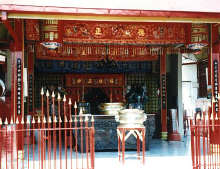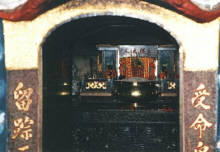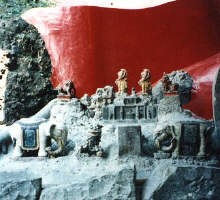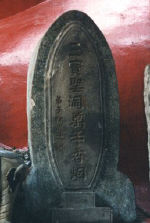Sam Poo Kong Temple – The Stone Building
Central Java, Indonesia


The northern coastal harbour-city of Semarang, Central Java, is a divided city – the old and the new. The old, being located on a coastal plain between two Banjir Canals, and the most interesting to explore. The new, being located in the Southern Candi hills, is the newer residential area and where most of the wealthy people live – the cool air preferable to the heat of the coastal plain. Semarang is a city full of history, culture, and is a bustling industrial centre. When I first visited the city, I arrived at the airport late at night. The air was humid, the airport empty except for a few sleepy porters and even sleepier taxi drivers. I had already arranged accommodation at the Metro Hotel in the old part of the city, near Pasar Johar – a huge labyrinth of market stalls where everything imaginable is for sale. The ten-kilometre distance from the airport, Ahmad Yani, to the city takes approximately fifteen minutes depending on how sleepy the driver is.


My hotel was situated next to a junction of five roads, known as simpang lima, where the roads branch out into various parts of the city. The next morning, Pasar Johar was my first challenge and I soon found myself eating boiled rice and fried chicken for breakfast. The market complex is a fruit lover’s delight. Rows of stalls join other rows leading into a complex of other markets right down to the canals, and the other side, into Chinatown. At almost every corner, and in every street there was some form of Dutch architecture and its prevalence, as in the rest of Java, seemingly dominant in its nature.
Cockfights, although illegal now, were still played out in the back alleys – the cocks displayed proudly in their bamboo dome cages, spurs fixed firmly on their feet. Vegetables, grown in the mountains were for sale, the women spreading sheets of old plastic on the ground upon which they spread their wares. Chilli, cucumber and the biggest tomatoes and potatoes I had seen were held up for my inspection. After three hours of orientation, I returned to the hotel to meet my penpal, Ariana, a school-teacher, and an expert on the history and culture of Semarang. Unfortunately, at the hotel there was a message. Ariana had been delayed and so a Becak would have to suffice for my ventures.
One of the objectives of my visit was to see the Chinese Temple (Klenteng) Gedung Batu, also known as ‘The Stone Building’, which dated back to the 15th Century. Situated roughly five kilometres from main part of the city on Banjir Canal Barat (West), it was supposedly a mosque originally. It was built to honour a Chinese Muslim, Admiral Cheng Ho, who traded (and raided, it was reputed) on the seven different occasions he visited the island of Java. Semarang, being a natural harbour, was ideal for his fleet of ships. The maritime escapades are evident inside the temple complex where anchor chains can be found just hanging in a tree and the hull of a wooden vessel.


A pagoda style entrance, on either side huge carved dragons, leads to the main building with its tall red columns and large four feet high candles always alight. Small shrines with their deities can be found on the right hand side as you walk through the entrance, but it is the main building itself, with its curved roof that is the most striking. It was built around what seemed like a massive rock wall, thus giving the temple the name of Gedung Batu – ‘Stone Building’. There is a small cave-like recess in the rock, high enough to enter, which is sacred and spiritual in its essence. Inside is the statue of Sam Poo Kong surrounded by flamed candles and burning incense. It is here, where people come from all over Java to meet the mystic and learn of their destiny by tossing josh sticks from a bamboo container or shaking vigorously until one josh stick leaves the container. This is then exchanged for a slip of paper – a fortune slip. It is said that this determines good fortune or bad, health or sickness, and love or disaster in marriage. When I finally met Ariana that night, she told me of a Chinese couple who visited there in search of their destiny together in marriage. The slip of paper caused no marriage to occur. Such is the belief in the spirits of Gedung Batu.


There is a stone tablet engraved in Chinese standing two feet in height. The photograph I took of it, I showed to a language professor friend of mine at Gadjah Mada University in Yogyakarta. To my surprise, he couldn’t translate its meaning. Nearby the tablet is a plaque in honourable memory of those sailors in the Admiral’s fleet who died on the various journeys from China to Java. Gedung Batu is a peaceful, serene place and best not visited on the weekends when the locals seem to fill the complex grounds. The time I visited, only a few people were there. It is a temple of striking architecture, buildings and columns painted brilliant red and yellow, and stark openness. As I walked to the entrance to leave, I hesitated and thought of having my fortune told, but then resisted – perhaps it was because my future had already been mapped out for me from birth.